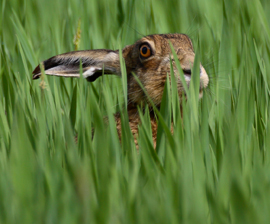-

Hares are often difficult to spot. Andy Fisher/www.andyfisherphotography.co.uk
Hares live above ground, mainly in farmland, and shelter in shallow depressions, known as “forms”, made in grassland or soil.
Lying low and motionless in the form, ears flat against their bodies, hares are difficult to spot, and they rely on this camouflage to protect them from detection by predators. If disturbed, they are capable of running fast in order to escape. Their diet consists mainly of grasses, herbs and cereals, and they prefer a mixed habitat of grassland and crops.
Breeding season
The hares’ famous “Mad March Hare” displays, where groups of up to a dozen or more chase each other and participate in bouts of “boxing”, take place in late winter and early spring. People often assume that the “boxing” involves males competing for mates, but it is actually unreceptive females pushing away amorous males. The main breeding season for brown hares runs from February to September; mountain hares have a slightly shorter season. The female conceals the young (leverets) in a form, visiting them daily for suckling until they are weaned at around 30 days old.
The hare is generally considered a relatively minor problem species in terms of damage to agricultural and forestry interests. [1]
The upland mountain hare
Living in inhospitable upland heather moorland, the main population of mountain hares—also known as blue hares—is found in Scotland, although a smaller number can also be found in the Peak District in England.
The brown/blue coat of the mountain hare moults to white in winter, a change which is understood to be triggered by the shortening daylight hours and which may provide some thermal advantage. A useful camouflage in a snow-covered environment, the white fur can be a burden too, leaving the hare more exposed and more vulnerable to predation in areas where snow is less prevalent, a problem that can only increase as climate change affects the UK’s winter weather.
Like the brown hare, the mountain hare generally lives above ground in a form, but during winter months it can lay-up in heather and scrape out a deeper form in snow to provide a more protective shelter from bad weather. Its diet consists of heather, hillberries, sedges and grasses and its young are generally born and raised from March to August.
Biodiversity Action Plan listing
Concern for its serious population decline saw the brown hare listed on the UK Biodiversity Action Plan, and a Species Action Plan created, in 1995. Recognition of population decline and the effect of climate change on its habitat resulted in the mountain hare being added to that Plan in 2007. [2] In addition, it is listed as a “species of community interest,” whose taking in the wild and exploitation may be subject to management measures, under Annex V of the EC Habitats Directive (1992). [3]
1. Natural England Species Information Note SIN001. http://naturalengland.etraderstores.com/NaturalEnglandShop/SIN001
2. UK BAP priority terrestrial mammal species. http://jncc.defra.gov.uk/page-5170
3. EC Habitats Directive (1992), species assessments. http://jncc.defra.gov.uk/page-4063
